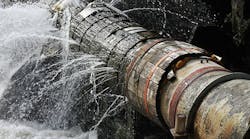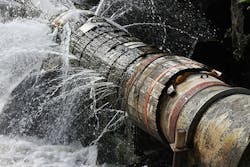Latest from Piping Contractor
Sponsored
Water infrastructure crisis could be a windfall for plumbers
CHICAGO— To maintain the nation’s current level of drinking water service over the next 25 years is going to require a trillion dollar outlay, according to a report from the American Water Works Association. The recent Clean Water and Drinking Water Needs Surveys from the U.S. Environmental Protection Agency estimates the combined total needed for water infrastructure investments over the next 20 years at $655 billion.
Water quality concerns, highlighted by the crisis in Flint, Michigan, have made the headlines, but are only the tip of the iceberg. “Poisoning thousands of people, it raises a red flag, but there are other issues behind the scenes,” Andrew G. Kireta, Jr., vice president of the Copper Development Association said.
Infrastructure in crisis
The Uni-Bell PVC Pipe Association reports 850 water main breaks a day, and the U.S. Geological Survey estimates more than 1.7 trillion gallons of treated water are lost to leaks annually, with 16 percent of treated water never reaching the tap. That adds up to a more than $50 billion dollar hit to the economy annually, with much of the bill footed by ratepayers.
“Leaks don’t really make the news,” Kireta said. “You’re losing water, but you’re also losing the chemicals it took to treat that water, the energy it took to pump that water. There’s a lot of money embedded in these infrastructure problems that goes unseen.”
Exacerbating the problem are new regulatory requirements and plumbing design changes. While almost everyone agrees on the need to conserve water, it can increase demand on the distribution infrastructure — an infrastructure in some places already at its limit
The situation is so serious that the Plumbing Manufacturer’s International — who’s members for the most part manufacture point-of-use devices — has issued a position statement advocating for the restoration of underground water infrastructure.
“We’re not the problem,” Barbara Higgens, CEO and executive director of PMI said. “We’ve done our best to modernize and meet demand.” However, when a homeowner sees orange water coming out of the tap in their kitchen, they tend to forget the miles of pipe leading up to that point and blame the tap. “So it is frustrating,” Higgins continued. “We’re doing our piece and we need others to do theirs as well.”
Jobs on the horizon?
One thing everyone familiar with the state of the U.S. water infrastructure agrees on: the longer we wait to take action, the more expensive the final cost will be.
“No matter what you do, it’s going to get more expensive the farther you put it off,” Kireta said. “The damage is going to get worse. This may actually be a great incentive to put more people back to work and bring them back into the plumbing trades.”
The infrastructure crisis is coinciding with the “skills crunch” of the plumbing trades. The average age of a professional plumber is now in their mid-50s, with fewer young people these days making the choice to take up a career in the trades (as opposed to, say, the 1960s-1970s). A comprehensive approach to the crisis will necessarily have to make an investment in skilled people, as well as materials and equipment.
“I think, just as with any other crisis, this will spur creativity,” Higgens said. “I think spilling out of that would be an attractive challenge for young people to get engaged, because they are already aware of how precious water is. That’s where our hope lies.”
Estimates on how many jobs the crisis could call for vary, but an economic benefit analysis study of the impacts of increased funding for the Drinking Water and Clean Water State Revolving Funds (SRF) released by the Water Environment Federation and the WateReuse Association revealed that a requested $34.7 billion of federal SRF spending could generate $102.7 billion in total economic input and create more than 500,000 U.S. jobs.
Money in the pipeline
Both presidential candidates have pledged to put the nation’s infrastructure high on their list of priorities. Hillary Clinton announced a $275 billion, five-year plan, and Donald Trump, while vague on specifics, has proposed creating infrastructure bonds and an infrastructure fund. However both candidates, when speaking about infrastructure, cite traditional transportation concerns: roads, bridges and airports.
But the inter-connected quality of the nation’s infrastructure means that addressing the problem will require a comprehensive approach. “It doesn’t make a lot of sense to build a road over the top of a water main that might already have problems,” Kireta said. “You can’t put all this money into surface infrastructure when the sub-surface infrastructure needs to be fixed.”
In June the House approved a bill to fund the FY17 Interior, Environment and Related Agencies Appropriations bill (HR 5538). The bill proposes to fund a number of infrastructure programs including:
- $2.1 billion for the Clean Water and Drinking Water State Revolving Funds (SRFs) administered by the EPA.
- $50 million for the new Water Infrastructure Finance and Innovation (WIFIA) program, which will generate an estimated $5 billion in water infrastructure construction; Congress recently passed legislation that lifted the ban on the use of tax-exempt bonds with loans authorized under WIFIA, making it a huge potential source of low-interest loans.
- $109.7 million for state grants (a $7.7 million dollar increase above the current level).
Also in June, the full Senate Appropriations Committee marked up and passed its version with changes to some of the funding levels ($2.37 billion for the SRF programs, for example). Resolving those differences is the next step in the legislative process.
Additionally there is a Senate bill, the Water Resources Development Act of 2016 (S 2848). Some of its key provisions include:
- A grant program to assist small and disadvantaged communities in complying with the Safe Drinking Water Act; $230 million for fiscal year 2017 and $300 million for each of fiscal years 2018 through 2021.
- A grant program for the replacement of lead service lines, testing, planning, corrosion control and education; $60 million for each of fiscal years 2017 through 2021.
- Authorizes $50 a year for EPA to make grants to accelerate the development of innovative technologies to address pressing water challenges.
The nitty gritty
Different municipalities will of course face different challenges. Some areas, particularly in the so-called “Rustbelt” of the Midwest, are in desperate shape, while other areas require little more than regular maintenance.
Choice of piping materials will depend upon local conditions, including seismic activity and the corrosiveness of the soil. The benefits of copper piping for use in service lines include a long history of reliability and corrosion resistance; what excessive leaching does occur is easily chemically treated. Copper prices are also going through a period of stability, making planning and budgeting that much easier.
Various plastic piping options, including PVC, CPVC and PEX, are available at a range of different price-points. Plastic pipes are easy to handle and install, and issues with reliability and longevity have been addressed, according to the manufacturers.
But whether piping in copper, plastic, iron, ductile iron or even steel, materials come second to man-hours. “Right now in the U.S. the average estimation of service line replacement is about $5,000,” Kireta said. “If you look at the difference between copper and plastic or any other type of material you might put in there, it’s less than 1.5-2.0 percent of the total cost of installation.”
Those billions of dollars are going to go to the people who can accomplish the excavation and extraction of old pipe, and the piping, fitting, valving and joining of the new pipe. It’s work that has to get done, and the plumber deserves the lion’s share.
Steve Spaulding | Editor-inChief - CONTRACTOR
Steve Spaulding is Editor-in-Chief for CONTRACTOR Magazine. He has been with the magazine since 1996, and has contributed to Radiant Living, NATE Magazine, and other Endeavor Media properties.



